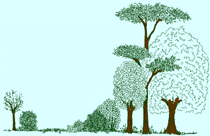 |
Permaculture design principles - grouped by design challenge |
||
|
Placement, integration and function Working with nature |
PLACEMENT, INTEGRATION AND FUNCTION
RELATIVE LOCATION
|
WORKING WITH NATURE Work with nature and not against Least effort for maximum effect OBSERVATION and PATTERNSObservation is important in getting a closer feel of a location such as watching how rainfall disperses or monitoring the way people walk through a space or arrange and use chairs. This sort of information is difficult to obtain from maps or books. It is site specific and it can change from day to day, season to season and so protracted observation may be required. Patterns in nature are revealed by observation, whether it is a useful pattern of activity that can be recreated or a pattern that can be incorporated to lend beauty.DIVERSITY of SPECIES and ELEMENTSDiversity protects us against any one elementís failure (a poor apple year may be a good raspberry year). Diversity alone does not produce stable systems. This happens if there is a useful relationship between the different elements such as in a plant guild where differing plants are combined in mutual benefit. |
|
|
BIOLOGICAL RESOURCES AND CYCLING Use natural resources sensibly Conserve or replace an equal or greater amount than used USE RESOURCES AT THEIR HIGHEST LEVEL Extend life by re-using or repairing rather than recycling. Rethink, redesign, reduce, reuse, repair, refuse, before recycling (the 7 Rís). Make the best use of a resource between its source and sink (where it arises and where it disappears) such as water flowing down a hill, or rainwater off a roof. Make water, wind and sun do work for you. ESTABLISH LOW MAINTENANCE SYSTEMS An unstable system requires work to maintain it i.e. a bare soil will soon have a flush of annual weeds germinating from seed blown in on the wind. Try to develop systems that are more stable and need less work to maintain them. Cover bare soil with mulches or keep perennially planted CYCLICAL PROCESSES INCREASE THE OPPORTUNITY FOR YIELD A waste is a pollutant looking for a use; so close the circle of use for resources as much as possible (outputs become inputs) and thus reduce losses |
SELL OFF ONLY WHAT CAN BE CARRIED OFFDonít take too much on. Use the least amount of land you need, freeing up some for wildlife. Supply yourself, then your locality and not the whole globe because you will be exporting your resources and could be sorely depleting them.SMALL SCALE SYSTEMSScale is important Ė make it humanscale and not tied to machinery. There is an optimum size over which there will be diminishing returns. |
||
|
START SMALL, START CLOSE Start at your back door and gain confidence from small successes rather than spreading your efforts too thinly. Do not re-invent the wheel when information may already exist Ė check maps, local knowledge. |
|||
|
MAXIMISE EDGE Edge effects occur whenever species, climate, soils, slope or artificial boundaries meet. They are rich in yields as they contain activities or species from both neighbour areas. Skills-crossover between communities can enrich our knowledge and help us develop. STACKING The concept of stacking recognises the spatial efficiency of the vertical layers of a woodland edge. Stacking can be time-based i.e. woodland bulbs flowering before the tree leaf canopy has had time to develop and cast shade. It can also be about supportive leadership (canopy people!) sheltering its young and supporting the growth below it. |
Yield is theoretically unlimited Everything gardens Problems contain their solutions EVERYTHING IS A GIFTWe should look at our lives as being a gift, seeing the positive in them, dwelling less on the negative (except where it has lessons for us) and becoming more content with what we have. Many things have an upside and a downside such that our good fortune may be a misfortune for others - we should put a limit on that. We should gain our satisfaction from a variety of yields and return our thanks for these gifts by our mature and ethical approach to life. |
||
|
Mark Fisher - Permaculture Design course handout notes www.self-willed-land.org.uk mark.fisher@self-willed-land.org.uk |
|||
| -top | |||